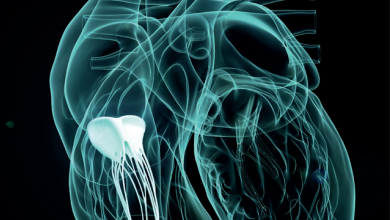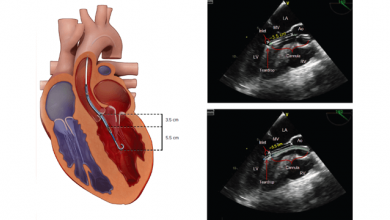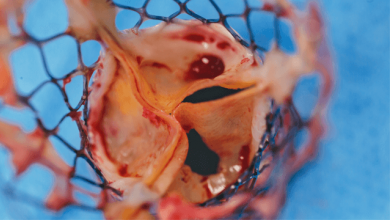Search results
Author(s):
Umaima Fatima
,
M Lekic
,
Sadiya Fatima
Added:
4 years ago
Author(s):
Luca Testa
,
Azeem Latib
Added:
3 years ago
Leaflet motion abnormalities (LMAs) are a relatively new entity in the field of transcatheter aortic valves (TAVs).1–4 They can be associated with the thrombosis of the bioprosthesis (TAVT), often leading to dramatic clinical scenarios1 or, on the other hand, they can result in a hypoattenuated leaflet thickening (HALT) and/or reduced leaflet motion (RELM), both usually associated with gradients…
View more
Author(s):
Amar Krishnaswamy
,
Emin Murat Tuzcu
,
Samir R Kapadia
Added:
3 years ago
Among patients undergoing surgical valve replacement, 1–5 % of patients with an aortic valve replacement (AVR) and 2–12 % with a mitral valve replacement (MVR) may develop paravalvular regurgitation or ‘leak’ (PVL).1–3 In the era of transcatheter aortic valve replacement (TAVR) with first-generation balloon expandable valves, up to 17 % of patients may be left with moderate or severe PVL, also…
View more
Author(s):
Sameer Gafoor
,
Jennifer Franke
,
Stefan Bertog
,
et al
Added:
3 years ago
Paravalvular leak (PVL) occurs when there is backflow around a prosthetic valve. This can occur through a variety of causes. Paravalvular Leak is accompanied by regurgitation and is often a significant problem for patients with bioprosthetic or mechanical heart valves.1 Often manifesting as heart failure (85% of all presenting symptoms) and hemolysis (13–47% of all presenting symptoms and signs)…
View more
Tricuspid Regurgitation: A Clinical Case-Based Review Of The Edwards Cardioband™ Tricuspid Valve…
Author(s):
Stephan Baldus
Added:
5 years ago
Article
Author(s):
Maurizio Taramasso
,
Christelle Calen
,
Andrea Guidotti
,
et al
Added:
3 years ago
The leading aetiology of tricuspid regurgitation (TR) in developed countries is functional, secondary to left side heart disease and pulmonary hypertension.1 Currently, moderate-to-severe TR affects approximately 1.6 million patients in the United States, of whom only 8,000 undergo tricuspid surgery annually;2 this results in an extremely large number of untreated patients with significant TR, a…
View more
Author(s):
Neil Ruparelia
Added:
3 years ago
Transcatheter aortic valve implantation (TAVI) is now the accepted treatment option of choice for patients presenting with severe symptomatic aortic stenosis who are deemed to be inoperable or of high surgical risk.1,2 Short- and intermediate-term outcomes have been promising3–5 and with increasing institutional and operator experience combined with technological advancements there has been…
View more
Author(s):
Joel P Giblett
,
Omar Abdul-Samad
,
Leonard M Shapiro
,
et al
Added:
3 years ago
Patent foramen ovale (PFO) is a common abnormality, occurring in 20–34% of the population.1 In the majority of infants, closure of the foramen ovale occurs soon after birth, as negative intrathoracic pressure associated with the first breaths closes the PFO. In some cases, the primum and secundum atrial septa fail to fuse and closure remains incomplete. There is continuing communication between…
View more
A Review of the Impella Devices
Author(s):
Rami Zein
,
Chirdeep Patel
,
Adrian Mercado-Alamo
,
et al
Added:
2 years ago
Article
Annular Rupture During TAVI
Author(s):
JJ Coughlan
,
Thomas J Kiernan
,
Darren Mylotte
,
et al
Added:
3 years ago
Article
















